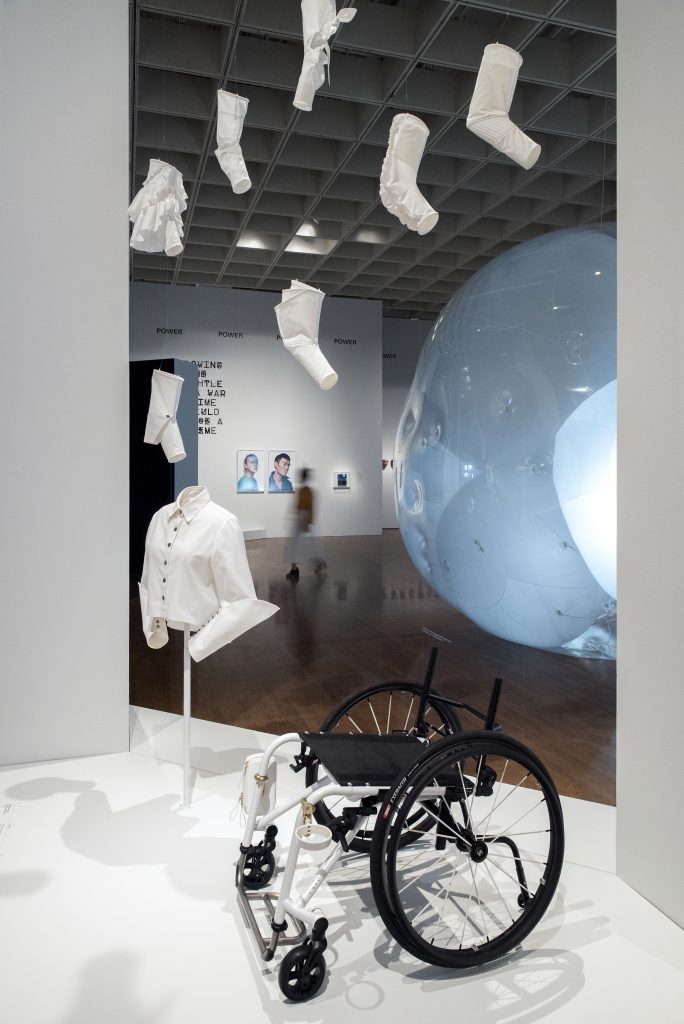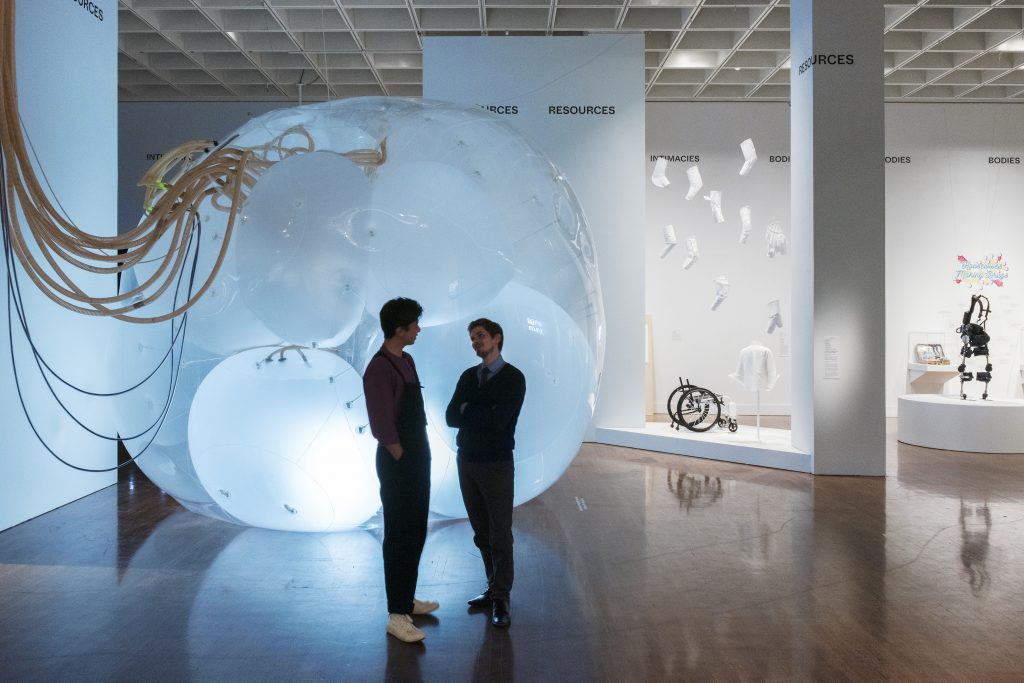
Designs for Different Futures
Philadelphia Museum of Art: October 22, 2019–March 8, 2020
Walker Art Center: September 12, 2020–January 3, 2021
Art Institute of Chicago: February 6 –May 16, 2021
The role of designers in shaping how we think about the future is the subject of a major exhibition that will premiere at the Philadelphia Museum of Art this fall. Designs for Different Futures brings together some 80 works that address the challenges and opportunities that humans may encounter in the years, decades, and centuries ahead. Organized by the Philadelphia Museum of Art, the Walker Art Center, Minneapolis, and the Art Institute of Chicago, Designs for Different Futures will be presented at the Walker and the Art Institute of Chicago following its presentation in Philadelphia.
Among the questions today’s designers seek to answer are: What role can technology play in augmenting or replacing a broad range of human activities? Can intimacy be maintained at a distance? How can we negotiate privacy in a world in which the sharing and use of personal information has blurred traditional boundaries? How might we use design to help heal or transform ourselves, bodily and psychologically? How will we feed an ever-growing population?
While no one can precisely predict the shape of things to come, the works in the exhibition are firmly fixed on the future, providing design solutions for a number of speculative scenarios. In some instances, these proposals are borne of a sense of anxiety, and in others of a sense of excitement over the possibilities that can be created through the use of innovative materials, new technologies, and, most importantly, fresh ideas.
Timothy Rub, the George D. Widener Director and Chief Executive Officer of the Philadelphia Museum of Art, stated: “We often think of art museums as places that foster a dialogue between the past and the present, but they also can and should be places that inspire us to think about the future and to ask how artists and designers can help us think creatively about it. We are delighted to be able to collaborate with the Walker Art Center and the Art Institute of Chicago on this engaging project, which will offer our visitors an opportunity to understand not only how designers are imagining—and responding to—different visions of the future, but also to understand just how profoundly forward-looking design contributes in our own time to shaping the world that we occupy and will bequeath as a legacy to future generations.”
Thinking about the future has always been part of the human condition. It has also been a perennial field of inquiry for designers and architects whose speculations on this subject—ranging from the concrete to the whimsical—can profoundly affect how we imagine what is to come. Among the many forward-looking projects on view, visitors to Designs for Different Futures will encounter lab-grown food, robotic companions, family leave policy proposals, and textiles made of seaweed.
“Some of these possibilities will come to fruition, while others will remain dreams or even threats,” said Kathryn Hiesinger, The J. Mahlon Buck, Jr. Family Senior Curator of European Decorative Arts after 1700, who coordinated the exhibition in Philadelphia with former assistant curator Michelle Millar Fisher. “We’d like visitors to join us as we present designs that consider the possible, debate the inevitable, and weigh the alternatives. This exhibition explores how design—understood expansively—can help us all grapple with what might be on the horizon and allows our imaginations to take flight.”

The exhibition is divided into 11 thematic sections. In Resources, visitors will encounter an inflatable pod measuring 15 feet in diameter, part of the work Another Generosity first created in 2018 by Finnish architect Eero Lundén and designed in this incarnation in collaboration with Ron Aasholm and Carmen Lee. The pod slowly expands and contracts in the space, responding to changing levels of carbon dioxide as visitors exhale around it, and provoking questions about the ongoing effect of the human footprint on the environment. The section titled Generations will explore ways in which the choices we make today may contribute to the well-being or suffering of those who come after us. Here, visitors will find a model of the Svalbard Global Seed Vault, a repository that stores the world’s largest collection of crop seeds. Located within a mountain on a remote island near the Arctic Circle, the facility is designed to withstand natural or human-made disasters. The Earths section of the exhibition speculates on the challenges of extra-terrestrial communication in Lisa Moura’s Alien Nations installation and showcases typeface from the 2016 science-fiction film Arrival.
In Bodies, designers grapple with choices about how our physical and psychological selves might look, feel, and function in different future scenarios. Featured here is one of the world’s lightest and most advanced exoskeletons, designed to help people with mobility challenges remain upright and active. Also notable is the CRISPR Kit, an affordable and accessible gene-editing toolbox, which has the potential to revolutionize biomedical research and open opportunities for gene therapy and genetic engineering.
Intimacies is a section that explores how technologies and online interfaces may affect love, family, and community. Here, urban experiences of sex and love are the focus of Andrés Jaque’s Intimate Strangers, an audio-visual installation focusing on the gay dating app. Through internet-enabled devices, designers explore the possibility of digitally mediated love and sex, suggesting what advanced digital networks hold for human sexuality.
Foods contains projects that explore the future of the human diet. Among them is a modular edible-insect farm, Cricket Shelter, by Terreform ONE, which offers a ready source of protein for impending food crises. A kitchen installation suggests how technology and design may contribute to new modes of food production, including an Ouroboros Steak made from human cells.
Additional sections of the exhibition will focus on the future of Jobs and how Cities will function and look 100 years from now—with robotic baby feeders, driverless cars, and other developments—affording a glimpse at how we might navigate living beyond this planet. Shoes grown from sweat are among the innovations visitors will find in a section devoted to Materials, while Power willlook at how design may affect our citizenship and help us retain agency over such essentials as our DNA, our voices, and our electronic communications in a future where the lines between record-keeping, communication, and surveillance blur. Data acknowledges and questions the different ways that information might be collected and used, with all its inherent biases and asymmetries, to shape different futures.

Futures Therapy Lab
As part of the exhibition, visitors to the Philadelphia Museum of Art galleries will also encounter a space for community meetups, public programs, school visits, and self-directed activities. The Futures Therapy Lab will weave personal connections between visitors and the exhibition as part of a collaboration between the museum’s Education Department and the curatorial team. Weekly programs, many of which will occur on Pay-What-You-Wish Wednesday Nights, will connect visitors with designers, artists, and locally based creatives. The Futures Therapy Lab will contain a crowdsourced Futures Library that includes everything from science-fiction books to the exhibition catalogue. “Thinking about possible futures is both exhilarating and anxiety-provoking,” said Emily Schreiner, the Zoë and Dean Pappas Curator of Education, Public Programs. “The Futures Therapy Lab is a place for conversation, critique, and creativity in which visitors can imagine their own hopes, fears and solutions for the future through reflection, discussion, and art making.”
Support
Designs for Different Futures is organized by the Philadelphia Museum of Art, the Walker Art Center, and the Art Institute of Chicago.
In Philadelphia, this exhibition is generously supported by the Annenberg Foundation Fund for Major Exhibitions, the Robert Montgomery Scott Endowment for Exhibitions, the Kathleen C. and John J. F. Sherrerd Fund for Exhibitions, Lisa Roberts and David Seltzer in honor of Collab’s 50th Anniversary, the Women’s Committee of the Philadelphia Museum of Art, the Laura and William C. Buck Endowment for Exhibitions, the Harriet and Ronald Lassin Fund for Special Exhibitions, the Jill and Sheldon Bonovitz Exhibition Fund, and an anonymous donor.
Publication
Centered on the innovative contemporary design objects, projects, and speculations of the exhibition’s checklist, the accompanying volume proposes design as a means through which to understand, question, and negotiate individual and collective futures, giving provocative voice to the most urgent issues of today. It asks readers to contemplate the design context within broader historical, social, political, and aesthetic spectrums. Designs for Different Futures addresses futures near and far, exploring such issues as human-digital interaction, climate change, political and social inequality, resource scarcity, transportation, and infrastructure.
The primary authors are Kathryn B. Hiesinger, Michelle Millar Fisher, Emmet Byrne, Maite Borjabad López-Pastor, and Zoë Ryan, with Andrew Blauvelt, Colin Fanning, Orkan Telhan, Juliana Rowen Barton, and Maude de Schauensee. Additional contributions include texts by V. Michael Bove Jr. and Nora Jackson, Christina Cogdell, Marina Gorbis, Srećko Horvat, Bruno Latour, Marisol LeBrón, Ezio Manzini, Chris Rapley, Danielle Wood, LinYee Yuan, and Emma Yann Zhang; and interviews with Gabriella Coleman, Formafantasma (Andrea Trimarchi and Simone Farresin), Aimi Hamraie and Jillian Mercado, Francis Kéré, David Kirby, Helen Kirkum, Alexandra Midal, Neri Oxman, and Eyal Weizman.
Designs for Different Futures will be distributed by Yale University Press. The book was overseen by Philadelphia Museum of Art publishing director Katie Reilly and editors Katie Brennan and Kathleen Krattenmaker. It is designed by Ryan Gerald Nelson, Senior Graphic Designer at the Walker Art Center, under the direction of Walker design director Emmet Byrne.
It is available in the museum store ($40) or via the museum website.
Designs for Different Futures
ISBN 9780876332900

Related Program
The Futures Therapy Lab will host a series of weekly happenings:
Artists in the Lab
Artists and designers share their work through talks, demonstrations, and workshops. Wednesday Nights, 5:00–8:45 p.m.
The Designer is In
Talk it out. One-on-one sessions with local designers offer new perspectives on your everyday life. Thursdays & Saturdays, 2:00–4:00 p.m.
Sci-Fi Sundays
Drop-in readings that explore narratives of the future. Select Sundays, 2:00–3:00pm
See Full Schedule of Related Public Programs
Curatorial Team
The curatorial team is comprised of: at the Philadelphia Museum of Art, Kathryn B. Hiesinger, The J. Mahlon Buck, Jr. Family Senior Curator of European Decorative Arts after 1700, and Michelle Millar Fisher, formerly The Louis C. Madeira IV Assistant Curator of European Decorative Arts after 1700; at the Walker Art Center, Emmet Byrne, Design Director and Associate Curator of Design; and at the Art Institute of Chicago, Maite Borjabad López-Pastor, Neville Bryan Assistant Curator of Architecture and Design, and Zoë Ryan, the John H. Bryan Chair and Curator of Architecture and Design. Consulting curators are Andrew Blauvelt, Director, Cranbrook Art Museum, Bloomfield Hills, Michigan, and Curator-at-Large, Museum of Arts and Design, New York; Colin Fanning, Independent Scholar, Bard Graduate Center, New York; and Orkan Telhan, Associate Professor of Fine Arts (Emerging Design Practices), University of Pennsylvania School of Design, Philadelphia.
Kathryn B. Hiesinger is The J. Mahlon Buck, Jr. Family Senior Curator of European Decorative Arts after 1700 at the Philadelphia Museum of Art. Her work focuses on decorative arts and design from the mid-nineteenth century to the present and includes the exhibitions and publications Zaha Hadid: Form in Motion (2011), Out of the Ordinary: The Architecture and Design of Robert Venturi, Denise Scott Brown and Associates (2001), Japanese Design: A Survey since 1950 (1994) and Design since 1945 (1983).
Michelle Millar Fisher is the Ronald C. and Anita L Wornick Curator of Contemporary Decorative Arts at the Museum of Fine Arts, Boston. She is a graduate of the University of Glasgow, Scotland, and is currently completing her doctorate in architectural history at the Graduate Center of the City University of New York. She is the co-author, with Paola Antonelli, of Items: Is Fashion Modern? (2017).
Emmet Byrne is the Design Director and Associate Curator of Design at the Walker Art Center in Minneapolis. He provides creative leadership and strategic direction for the Walker in all areas of visual communication, branding, publishing, while overseeing the award-winning in-house design studio. He was one of the founders of the Task Newsletter in 2009 and is the creator of the Walker’s Intangibles platform.
Maite Borjabad López-Pastor is the Neville Bryan Assistant Curator of Architecture and Design at the Art Institute of Chicago. She is an architect and curator educated at the Universidad Politécnica de Madrid and Columbia University, New York. She is the author and curator of Scenographies of Power: From the State of Exception to the Spaces of Exception (2017). Her work revolves around diverse forms of critical spatial practices, operating across architecture, art, and performance.
Zoë Ryan is the John H. Bryan Chair and Curator of Architecture and Design at the Art Institute of Chicago. She is the editor of As Seen: Exhibitions That Made Architecture and Design History (2017) and curator of In a Cloud, in a Wall, in a Chair: Six Modernists in Mexico at Midcentury (2019) and the 2014 Istanbul Design Biennial, The Future is Not What it Used to Be. Her projects explore the impact of architecture and design on society.
Social Media
Twitter/Facebook/Instagram/Tumblr/YouTube: @philamuseum
We are Philadelphia’s art museum. A world-renowned collection. A landmark building. A place that welcomes everyone. We bring the arts to life, inspiring visitors—through scholarly study and creative play—to discover the spirit of imagination that lies in everyone. We connect people with the arts in rich and varied ways, making the experience of the Museum surprising, lively, and always memorable. We are committed to inviting visitors to see the world—and themselves—anew through the beauty and expressive power of the arts.
Thank you to the Philadelphia Museum of Art for the content of this post.
Read my review on DoNArTNeWs.com
Like DoNArTNeWs Philadelphia Art News Blog on facebook
Follow the new DoNArTNeWs.com
Follow DoN on Twitter @DoNNieBeat58
@donniebeat on Instagram
Affiliate Marketing [disclosure page] Shop on-line and help support DoNArTNeWs
Donate via safe and secure PayPal in the sidebar.
DoNArTNeWs – celebrating eleven years reporting on Philadelphia artists and art.

Pingback: Art Food, Designs for Different Futures, Orkan Telhan, Dough with encapsulations, Philadelphia Museum of Art
Pingback: Designs for Different Futures, Philadelphia Museum of Art